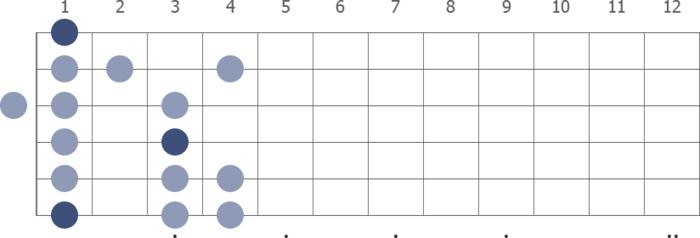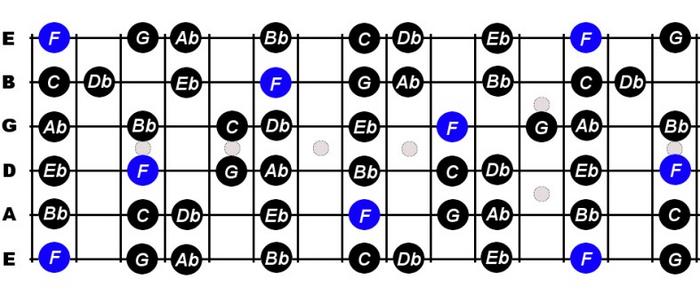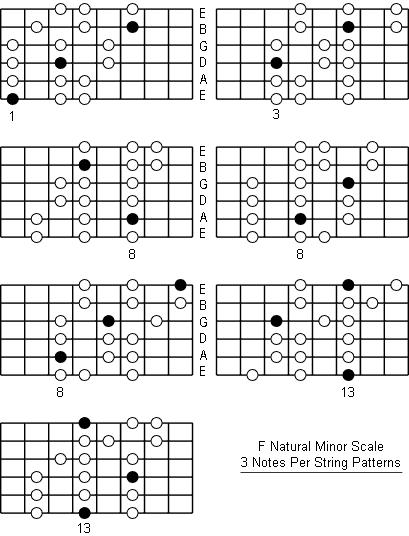Greetings, I’m Robert Williams, with years of guitar-playing under my belt. Ever heard the expression that ‘music is the universal language’? You could say, when it comes to guitar, that language becomes even more profound when you master the F minor scale. Like learning a new dialect, understanding the F minor scale on the guitar can open new avenues of expression, musical exploration, and even the potential for storytelling in your guitar playing.
Intriguingly, the F minor scale guitar lends itself particularly to producing poignant, dramatic soundscapes—one might even say that it’s the Shakespeare of guitar scales. Yet, its mastery remains elusive to many. But, worry not! With my extensive experience and passion for the guitar, I’m excited to guide you through the process, amplifying your understanding and proficiency of the F minor scale on the guitar.
Embrace this opportunity for growth. Get ready to unlock new realms of creativity and depth in your musical journey. So, let’s delve into mastering the underappreciated hero of the musical world, the F minor scale guitar.
Understanding the F Minor Scale
Basic Theory Behind F minor Scale

Diving deeper into the theory, let’s unpack our focus: the F minor scale. At its core, this scale belongs to the family of minor scales, known for their mystic, sombre tone. The key component of the F minor scale is its key signature. This signature contains four flats, namely: Bb, Eb, Ab and Db.
Each minor scale has a relative major scale, and vice versa. The F minor scale, in particular, shares its nuances with the Ab major scale. Consequently, unraveling the theory behind F minor would provide a solid foundation for learning its relative major too.
So, if we translate this theory into the language of music, F minor’s chilling beauty emerges when the minor key signature and relative major merge, creating aural magic.
With years of teaching experience and a specialization in Contemporary Improvisation, I can confidently declare the F minor scale as a muse for musicians. It’s fascinating how such a minor shift in flats and sharps can craft a whole new emotional and harmonic terrain. Nonetheless, understanding the intricacies of the F minor scale, as well as its theoretical underpinnings, is crucial in mastering the art of improvisation.
Pressing forward, we’ll detail the notations of this dark, mysterious scale and learn how to visualize the F minor scale on the guitar. Undoubtedly, knowledge of how each note, chord, and technique ties into the wider theoretical framework will empower your musical journey with the F minor scale.
Notations of F Minor Scale

Deepening our exploration, we now unearth the notations of the F minor scale. As a transcriber, notations hold a special place in my heart. Indeed, they serve as our roadmaps, guiding us along those melodious paths we seek to tread. To demystify them, I’ll walk you through F minor scale tabs, elucidating every step with meticulous attention to detail and clarity.
The main feature of any minor scale, F minor included, is its uniquely somber tonal quality; a harmonic contrast to its cheerful major counterpart. The notes are F, G, Ab, Bb, C, Db, and Eb. The relevance of these notations lies not only in being the building blocks of the F minor scale but more importantly, as the origin of other harmonious proportions.
Equally essential are the F minor scale tabs that transcend plain theoretical knowledge, providing a tactile connection between the music and your fingers on the fretboard. These notations are instrumental in cultivating a rich understanding of the F minor scale.
As we transition forward, remember that these notations are not rigid, dogmatic rules but flexible tools. Visualise them on your guitar. Let your fingers familiarise with the spaces between each note, experience the distinctive tonal aura, and watch as these notations sweep you into a melodious conversation with your instrument. Keep in mind, mastery is achieved in stages. Thus, each segment such as Visualizing the F Minor Scale on Guitar and Learning to Play the F Minor Scale in the forthcoming sections adds value to enhancing your overall understanding and proficiency in the F minor scale.
Visualizing the F Minor Scale on Guitar

Having devised techniques to etch intricate designs onto hard surfaces, I’m well acquainted with the significance of visualization, sculpting my craft meticulously and with precision. This very concept applies beautifully when bringing to life the melodious transitions of the F minor scale on a guitar. Powering this visualization through a guitarist’s lens is about tracing this journey, feeling each note as it resonates through your fingertips, echoing in your heart. It’s much more than a technique; it’s an experience, a feeling, a connection. And this connection is crucial when we explore F minor scale fingerboard diagram.
Want to sense your way around your guitar fretboard intuitively? Let’s tap into the power of visualization together. You see, I wholeheartedly believe in the concept of guitar fretboard visualization. The same way I can sense the feel of an engraving tool beneath my deft fingers, I strive to convey the same understanding for you with the guitar.
Imagine allowing your fingers to dance gracefully over your guitar’s fretboard, your mind illuminated by the visualization of the F minor scale. This mental image does more than guide your fingers to the right notes – it enables you to ‘see’ the music before you play it, paving the way for imaginative improvisation and effective communication with other musicians.
The F minor scale consists of seven notes: F, G, Ab, Bb, C, Db, and Eb. Visualizing these notes across the fretboard can seem daunting at first. But trust me, with practice and patience, it gets easier. Imagine the fretboard as a grid, with the F minor scale mapped onto it. Each fret denotes a semitone upwards, and as you move across each string, refer back to the F minor scale fingerboard diagram to guide you.
I wholly resonate with the struggles beginner guitarists face. Even seasoned guitarists can occasionally find themselves lost on the fretboard. But this is where visualization is key. To ease the complexity, I often recommend experimenting with different F minor scale positions and patterns on your own guitar. This hands-on experience will improve your memory of scale patterns and assure you an intuitive understanding of the fretboard.
It’s true what they say – the beauty is in the details. Mastering the F minor scale on a guitar involves taking in these finer details, deeply ingraining them into your being. And during this transformative journey, fret not if mistakes happen or if progress seems slow. Remember, even as an experienced engraver, I’ve had my share of missteps. But these very missteps shape the melody of beautiful music, as they did the designs etched forever with an engraver’s touch.
So, let the visualization guide you, unlock emotions you never deemed possible with every note, every strum on the string. This, my friend, is more than learning a new guitar scale; it’s about embracing the music, embodying the rhythm, and expressing the song that’s in your heart.
Learning to Play the F Minor Scale
F Minor Scale Positions & Patterns

Just as we’ve explored the theory and notation of the F minor scale, it’s essential to understand how to physically manifest these concepts on our guitar. We’ll dive into the intriguing world of F minor scale positions and patterns here, an essential segment within the learning process.
As I explained in my book “Color your Chords,” I admire the task of exploring and mastering new scales. The same sense of intrigue applies to the F minor scale positions. Remember, each position points to a distinct starting point on the fretboard from where you can play the scale. You’ll uncover seven F minor positions in all, each offering a different color of sound, so to speak. Familiarising yourself with each of these positions allows for versatility in your playing and enables you to play the scale across the neck.
Moving to F minor scale patterns, they form the heartbeat of any scale, providing a road map for your fingers as you play. Patterns help reinforce muscle memory, and let you play the scale without conscious thought. Regarding our focus, the F minor scale, specific patterns repeat across the fretboard. Absorbing these patterns will enable you to shift seamlessly between positions while ensuring fluidity in your melodies and solos.
I highly recommend incorporating these patterns into your practice routine. When doing this, emphasize on not just playing them right, but understanding them.
Playing the F minor scale will indeed be challenging initially. Nevertheless, once you start recognising these positions and patterns, you’ll find yourself navigating the fretboard with increased confidence and ease. The beauty is that each challenge you overcome while mastering the F minor scale will deepen your understanding and capability of conveying your musical ideas.
As we progress to the next section, we’ll explore the harmonic and pentatonic variations of the F minor scale to enhance your playing skills further. The journey towards mastering the F minor scale continues, and these ‘positions and patterns’ form crucial milestones in this delightful voyage.
Harmonic and Pentatonic Variations

Delving into the world of harmonic and pentatonic variations of the F minor scale will truly hone your expertise as a guitarist. These variations bring new depth and color to the familiar F minor territory, adding a rich spectrum of possibilities. Armed with my years of practical experience in transcription and improvisation, I am excited to guide you through this enlightening journey.
The Harmonic Minor Scale introduces a distinctive, almost exotic flavor to your music. Here in F minor, the key difference lies in the seventh note. In contrast to the natural minor scale, which employs a flat seventh, the harmonic minor lifts up the seventh by a half-step. In F minor that means using E instead of E flat. This minor tweak opens up a realm of complex melodic and harmonic possibilities. The raised seventh creates an augmented second interval with the sixth which lends a unique, characteristically ‘Eastern’ sound to your playing.
Moving on to the Pentatonic Minor Scale, it’s the essence of simplicity, yet it can create impactful, soulful melodies. This scale uses only five notes, hence the name pentatonic. In F minor, these are F, Ab, Bb, C, and Eb. The absences of the second and the sixth from the original F minor scale give it an open, less defined quality, perfect for improvisation and creating emotional solos. The stripped-down nature of the pentatonic scale allows for melodic clarity, offering an excellent starting point for beginners, but also a go-to tool for more experienced improvisers.
Understanding variations such as these allows us as guitarists to unlock limitless musical potentials and underscores the vitality of learning to understand and play the F minor scale. In my experience, becoming proficient with these variations has been nothing short of transformative, enhancing my musical repertoire and improvisation skills tremendously.
Let’s keep ascending on this journey of mastering the F minor scale, reaching for new heights with the expanding panorama of related scales and chords that await us next.
Related Scales and Chords

In my many years of playing and teaching guitar, I’ve always been captivated by the fascinating interplay between scales and chords. The way they intertwine to lay the foundation for different genres and styles of music never ceases to amaze me. This is also where the F minor scale reveals a unique depth of character and potential.
Ready to expand your musical horizons? Let’s delve into the captivating web of relationships between the F minor scale and other scales and chords. A profound understanding of these connections will offer you a more nuanced grasp of your guitar fretboard, keeping your performances and compositions versatile and adaptable.
To start, let’s consider how the F minor scale interacts with other scales. You’ve probably already noted the close relationship between F minor and its relative major, Ab major. These two scales share the exact same notes but start on different root notes, highlighting the beauty of relative keys’ relationship. But if you venture further, you’ll discover harmonic and melodic variants of F minor scale, each providing unique colorations and dramatic twists.
Now, let’s talk about the F minor chord. This is the primary harmonic ‘home’ within the scale, the chord that ultimately gives the F minor scale its identity. You play it differently on the guitar compared to other minor chords. Digging deeper, we find it’s a part of a much larger family, interconnected with other chords like F minor 7, F minor 9, and F minor 11, each adding additional layers of tonal complexity.
Your exploration shouldn’t stop there. Mapping each note of the F minor scale to triads or seventh chords leads to the discovery of the underlying chord progression that’s native to the scale. From F minor to G minor, Ab major to Bbm, C minor to Db major and so on, this sequence forms the harmonic backbone of countless compositions.
Just remember, understanding these relationships isn’t merely about learning some abstract theory. It’s about empowering your musical voice and enriching your capabilities as a guitar player. As you experiment with different guitar scales and explore these relationships, you can truly unlock the vast potential hidden within the F minor scale.
As we proceed through this guide, we’ll examine these relationships more closely and provide practical exercises for mastering not just the F minor scale, but also how it interacts with related scales and chords. I’m hopeful that my own passion for the guitar’s intellectual and artistic depth will echo in your own journey.
Exercises to Master F Minor Scale

As I reflect on my musical journey, the countless hours I invested in mastering the guitar continue to resonate with me. A significant chunk of those hours was devoted to understanding and mastering scales, particularly the F minor. From my days at the Conservatory till now, daily practice has been my mantra. Let’s dive together into some effective F minor practice exercises.
The first exercise involves playing the F minor scale moving up and down the fretboard. Slowly play through the F minor scale, starting from the 1st fret on the low E string (F note) up to the 6th fret of the B string and back down. This exercise will familiarize you with the placement of the notes on the guitar neck.
Next, practice the F minor scale in different positions. This will help you to understand the scale shape and its positions on the fretboard. Ensure that you start and end on the root note. The more you practice, the more fluent your fingers will become, allowing for effortless transitions between different positions.
Want to sound like a pro on the guitar? These proven exercises will take you a step closer to mastering the F minor scale. One of my favorites includes playing the F minor scale using alternate picking. This not only aids you in gaining speed and precision but will also help you develop your picking technique.
A progression to this would be to play the F minor scale in broken thirds, fourths, and fifths. For beginners, simply repeating the scale in the ascending order is great practice. But once you are comfortable, start practicing the scale backwards, in the descending order.
The significance of the F minor scale cannot be overstated in music. Practicing and mastering the F minor scale will invite a wealth of opportunities for you as a guitarist. It will provide you with a strong foundation for improvising or writing your own music.
Always keep in mind that whilst these exercises can help improve your scale fluency, you must also incorporate theory aspects in your practice. Reviewing the related scales and chords, understanding the basic theory behind the F minor scale, and learning to visualize the F minor scale are few of the many topics we’ve covered in the previous sections for you to refer back to.
A step-wise approach, consistent practice, and above all, patience, will help you master the F minor scale on the guitar. Remember, it’s a gradual process. It will take time, but the results will be worth the effort.
FAQs
What is the F minor scale on the guitar?
How do I play the F minor scale on the guitar?
Is it important to use a metronome when practicing the F minor scale?
Should I learn other scales before the F minor?
Conclusion
Are you ready to step into the realm of musical masterminds? Hold onto that F minor scale guitar! Let’s recap what you have absorbed thus far, and visualize the path ahead. Starting from a thorough understanding of the F minor scale, you delved into basic theory and notations, then began visualizing, practicing, and mastering the F minor scale on your guitar. You’ve intelligently navigated various positions, patterns, and variations, including harmonic and pentatonic. You’ve also gained insight into related scales and chords, fortifying your musical prowess.
For me, from writing for ‘Premier Guitar’ and ‘Acoustic Guitar’ to conducting workshops, every step of my journey has enriched my understanding of the guitar’s science and soul. Now, I pass this understanding onto you, as we conclude our exploration and bring the power of the F minor scale into your repertoire. With this newfound knowledge, endless creative possibilities await.
Remember, mastery lies in persistence, so don’t forget to incorporate regular exercises. Keep the FAQs handy to clarify any queries along the way—your growth on this instrument is limitless. And most importantly, enjoy the ride as you play and explore the beautiful universe of guitar music.